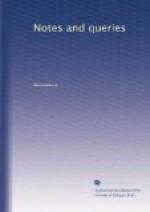M.
"Who was Temple Stanyan?" (no. 24. p. 382.) Temple Stanyan was the son of Abraham Stanyan, Esq., a Member of the Kit Kat Club, M.P. for Buckingham, Ambassador to the Porte, a Lord of the Admiralty, etc. Mr. Temple Stanyan was himself also Minister at Constantinople, and at several other courts; and afterwards Under-Secretary of State under both Addison and the Duke of Newcastle. He published in 1714 an Account of Switzerland; and his Grecian history in 2 vols. was, till the publication of Mitford’s, the best in our language. I believe that his daughter married Adm. Sir Charles Hardy. He died in 1752.
C.
Auctorite de Dibil (no. 25. p. 205.).—Probably an error of transcription; read Auctorite de Bibil.
J.M.B.
The Bristol Riots (No. 22. p. 352.).—“J.B.M.” is informed, that the volume to which he alludes is generally considered by Bristolians as the most authentic and fullest narrative that was published of those disgraceful scenes.
J.M.G.
Worcester.
Religious Tract by F.H. (No. 25. p. 400.)—The author of the religious tract which has fallen into the hands of “J.C.” is no doubt one of the early Quakers, and probably Francis Howgill. Howgill was originally a clergyman of the Church of England, but afterwards became a Baptist, and in the year 1652 joined the early Quakers, upon hearing the preaching of George Fox. His works were published in folio, in 1676, by Ellis Hookes.
[Greek: Theta]. {461}
Complutensian MSS.—“E.M.B.” (No. 25. p. 402.) will find full answers to his Queries, and more interesting information on the same subject, in a note in vol iv. p. 235. of Don Pedro Saban’s Spanish translation of Prescott’s Ferdinand and Isabella. Madrid, 1846.
I am told by an American gentleman, who has seen the MSS. within a month in the library of the University of Madrid, wither they were removed from Alcala in 1837, that the Chaldaic and Hebrew manuscripts are all originals, and on parchment. The only MSS. of Zamora among them are 3 vols. in Latin, translated from the Hebrew.
The Greek MSS., or some of them, are still with the collection as above; and of course were not returned to the Vatican.
H.S.
Morley’s Hotel, April 28.
Tablet to Napoleon (No. 17. p. 263., No. 25. p. 406.).—“C.I.R.’s” interpretation can hardly be admitted. The true meaning will be best exhibited by the following form:—
“Napoleoni,
AEgyptiaco,
Bis Italico,
Semper Invicto.”
Bis Italico alludes to his twice conquering Italy, viz., in his first campaign, and again in that of Marengo.




